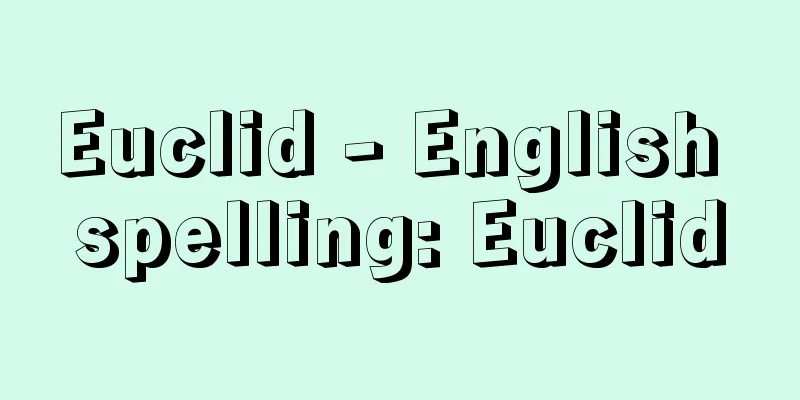Euclid - English spelling: Euclid

|
Date of birth and death unknown. Greek mathematician and physicist active in the first half of the 3rd century BC. His name is Eukleides in Greek. His career is unclear, but he was a student of Plato, and it is highly possible that he studied at the Academy in Athens and came into contact with Aristotle's learning. He is thought to have then moved to Alexandria, where he continued his writings. However, his relationship with the Mouseion, an academic research institute in the city, is unclear. Regarding his personality, Pappus, a mathematician from the late 3rd century, praised him for his humility and consideration for others, and said that he never took the initiative or took someone else's discoveries for his own. However, he was strict with students who did not understand. For example, according to the 5th century writer Stobaios, a man who had begun to study geometry under Euclid asked him, when he learned the first theorem, what profit could he get from studying such a thing? He then called his slave and said, "Now that this man has studied, he wants to make some money, so give him three obolos (a monetary unit)." His representative work is the 13-volume Stoikheia (translated as Elements or Geometry). He was commonly referred to as ho stoikheiotes (author of the Stoikheia) rather than by his name, and Euclid and geometry have become synonymous. Other surviving works by Euclid include Dedomena (Auxiliary Treatise), which deals with plane geometry, Deridiaireseon biblion (Derivation of the Division of Figures), which has been transmitted through Arabic, Optika (Optics), which assumes that we see things when rays of light leave our eyes and strike the objects we see, Katatome (Deciphering Intervals), and Eisagoge harmorike (Introduction to Harmony). [Hirata Hiroshi] "Euclid's Elements, translated by Nakamura Koshiro et al. (1972/Supplementary edition 2011, Kyoritsu Publishing)" ▽ "History of Greek Mathematics I and II, by T. L. Heath, translated by Hirata Hiroshi et al. (1959/Reprint edition 1998, Kyoritsu Publishing)" ▽ "Euclid, by Nakamura Koshiro (1978, Tamagawa University Press)" [Reference] | |Source: Shogakukan Encyclopedia Nipponica About Encyclopedia Nipponica Information | Legend |
|
生没年不詳。紀元前3世紀前半に活躍したギリシアの数学者、物理学者。ギリシア語読みではエウクレイデスEukleides。その経歴ははっきりしないが、プラトン学徒らしいことは確かで、その点からアテネのアカデメイアで研究したり、アリストテレスの学問に接した可能性は大いにありうる。そして、そののちはアレクサンドリアに移って著作活動を続けたと思われる。しかし、この都市にある学問の研究所ムセイオンとの関係は不明である。彼の人柄については、3世紀後半の数学者パッポスが、謙遜(けんそん)と他人への思いやりがあったと称賛し、抜け駆けをしたり、他人の発見を自分の発見にするようなことはけっしてしなかったと述べている。しかし無理解な門人には厳格だったらしい。たとえば5世紀の文人ストバイオスStobaiosによると、ユークリッドのもとで幾何学を学び始めたある男が、最初の定理を学んだとき、こんなことを勉強してどんな利益があるのかと彼に尋ねた。すると彼は奴隷をよんで、「あの男は勉強したからにはどうしても金もうけがしたいらしいから、3オボロス(貨幣単位)やってくれ」といったという。 彼の代表的著書は『ストイケイア』Stoikheia(『幾何学原本』『原論』などと訳す)13巻である。彼のことを名前でなく「ストイケイアの著者」ho stoikheiotesとよんで通用したし、ユークリッドと幾何学とは同意語になったほどである。ユークリッドの現存している著書には、そのほかに、平面幾何学を扱った『補助論』Dedomena、アラビア語を通じて伝わっている『図形の分割について』Deridiaireseon biblion、『光学』Optika(物が見えるのは、光線が目から発し、見られる物体に突き当たると仮定している)、『音程論』Katatome、『和声学入門』Eisagoge harmorikeなどがある。 [平田 寛] 『中村幸四郎他訳『ユークリッド原論』(1972/追補版2011・共立出版)』▽『T・L・ヒース著、平田寛他訳『ギリシア数学史 Ⅰ・Ⅱ』(1959/復刻版1998・共立出版)』▽『中村幸四郎著『ユークリッド』(1978・玉川大学出版部)』 [参照項目] | |出典 小学館 日本大百科全書(ニッポニカ)日本大百科全書(ニッポニカ)について 情報 | 凡例 |
>>: Yukuhashi [city] - Yukuhashi
Recommend
Employment income deduction - Employment income deduction
A term used in the Income Tax Act. Wages, salaries...
Bransfield, E.
…At the same time, voyages to the southern seas a...
Sterling Area (English spelling)
...countries whose national currencies are linked...
Free-spirited father - Free-spirited father
...Rakugo. The original story is "The Free-s...
Elevator - elevator (English spelling)
An elevator that moves a cage carrying people or ...
Beneficiary burden - Beneficiary burden
This is when national and local governments requir...
Hirao [town] - Hirao
A town in Kumage County, occupying the western hal...
Ando Bugyo - Ando Bugyo
〘 noun 〙 A post in the Kamakura and Muromachi Shog...
Wǎng chuān tú juàn (The Scroll of the River Wang)
A scroll depicting the villa of Wang Wei during th...
Saigokusujigundai - Saigokusujigundai
During the Edo period, this was a position that g...
Name - Name
A term used in Noh and Kyogen. It is also written ...
Cladophora sauteri (English spelling) Cladophorasauteri
…[Mitsuo Chihara]. . . *Some of the terminology t...
《Space War》
...Generally it means an invader from outside, bu...
Gansu Corridor (English: Gansu Corridor)
A corridor-like plain about 1000km long and severa...
Kimiaki Ogimachi - Kimiaki Ogimachi
Year of death: 13th October 1910 (5th November 181...









